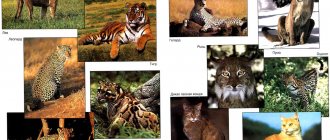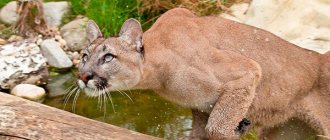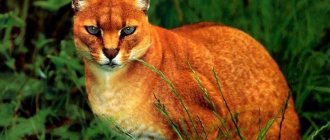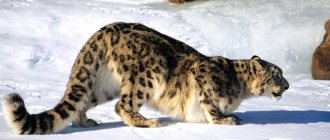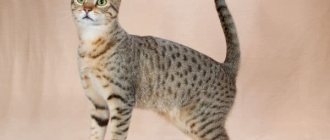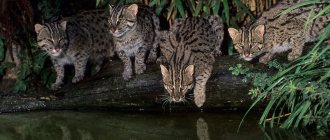Many are convinced that only large black animals belonging to the cat family are called panthers. From the point of view of biological classification, such a statement is incorrect. The genus Panthera includes five species of modern predators: lions, tigers, jaguars, leopards and snow leopards, as well as a number of fossil animals. The presence of black coloring is not a prerequisite for calling an animal a panther.
Description of panthers
Panther
Panther belongs to the genus of large predatory animals from the cat family.
This genus is represented by four living all known predators: tiger, leopard, lion and jaguar. The panther is none other than a representative of the leopard (read our article: the biggest cats in the world). Although there is still controversy over who exactly the panther belongs to, jaguars or leopards. Panthers are distinguished because of their color, because many of them have an even color, most often black. Interesting fact : due to its majestic appearance, the panther was used on the emblem of English kings. Nowadays it is present on the coat of arms of the African country of Gabon.
№9
They are very territorial predators. This is especially true for males. They will be aggressive towards both females (except during the mating season) and males. Typically, males control a significantly larger territory than females.
Also, females often share territory with other females without showing aggression towards them.
Appearance of panthers
Appearance of panthers
These wild animals have a muscular body, which reaches a length of 95-180 cm, a tail - 70-115 cm. The weight of panthers usually ranges from 40-55 kg, but some individuals can reach 100 kg. The tail accounts for up to half the length of the body, sometimes more; thanks to this assistant, they maintain excellent balance and feel comfortable even at high altitudes. Panthers are very graceful animals, but behind their external beauty and grace lies a real ruthless predator that can easily attack a person.
Wool
The fur of these animals is hard, it covers the entire body and most often has a black color, but if you look closely, you can see spots of dark shades of various kinds.
Panther
The panther moves on four powerful limbs, easily climbs trees and jumps well. At the ends of its paws there are sharp claws that can be completely hidden by retracting into the fingers. The height of the animal at the withers reaches 50-70 cm.
Head
Panther fangs
The head of the predator is large and has a somewhat elongated shape. At the top of the head there are small ears. The eyes are medium in size with round pupils. The panther has powerful jaws with a complete dental system. The canines are not large compared to other wild cats, but they are quite powerful and have a wide base. A predator can easily climb a tree while holding the body of its prey in its mouth.
It is impossible not to note the main feature of panthers - the structure of their larynx. They have a not completely ossified hyoid apparatus, in which there is a flexible ligament, thanks to which the larynx is able to swell and the panther can emit a kind of roar. In addition to this feature, the animal’s vocal cords also do not separate, but form a tubular structure. Thanks to this structure, the roar is very loud and deep.
Interesting: Why do cats wash themselves, but dogs don’t? Reasons, photos and videos
№4
These are elusive predators. One of the main features that sets black panthers apart from other big cats is their stealth. They are predominantly nocturnal. The dark color of their fur allows them to blend into their environment, and their excellent vision and sense of smell help them find prey even in pitch darkness. They usually hunt on the ground, but they also ambush prey by climbing into trees.
What do panthers eat?
Panther on the hunt
The panther is a carnivorous predator, so its diet can include any animal. The wild cat gives preference to artiodactyls, and the size of the prey does not matter: among them there are zebras, antelopes, buffalos, roe deer, etc. It can also attack livestock; cows, sheep, and goats can become victims.
Despite the fact that the panther hunts mainly on the ground, while resting in a tree it may also be interested in a monkey as a potential victim. This predator can go without food for 5-6 days , but in this case the feeling of hunger takes over the cat so much that it begins to pose a great danger to the person whom it is ready to attack without hesitation.
These predators usually look out for their prey and lie in wait, waiting for the right moment. When the game comes closer, the panther can overtake it in several jumps, and, if necessary, can rush to catch up, developing speeds of up to 60 km/h. It is difficult to escape from this predator or escape from its tenacious clutches.
№11
These are skilled swimmers, especially if they are jaguars. Unlike a number of other cats, they go into the water not only out of necessity (for example, to swim to the other side), but also to hunt fish or cool their body temperature when they are very hot.
They are also excellent tree climbers, especially if they are leopards, which spend most of their time in trees.
Character and lifestyle
This predator does not live in a pack, but wanders on its own. Prefers to hunt large animals. Its diet is dominated mainly by ungulate mammals: antelope, buffalo, zebra. Sometimes a wild cat is not averse to snacking on a monkey.
Panther
Why does a panther drag its prey up a tree?
A panther can attack an animal that is larger in size - few can compete with this predator in strength and agility . She can easily drag any caught prey up a tree and have her meal there. This manner of hiding its food is also connected with the fact that in this way the panther protects its prey from attacks by hyenas and lions that roam the earth. This is another distinctive feature of leopards, because only they drag their prey into trees.
Panther on a tree
Leopards, which include the panther, love to rest in trees, they even sleep there. They stretch out on the branches and casually hang their paws down. Panthers can jump onto trees up to 5.5 meters high ; no other predator can boast of such jumping ability.
It is curious that a wild cat kills only when it feels hungry; if the predator is full, then even if a small kid is in front of its nose, the panther will not touch it . But when a predator is hungry, it can even attack a person. Panthers often settle near human dwellings and can enter its territory without any problems. They like to hunt at night, so there are cases of attacking a person in a dream.
Interesting: Why do cats respond to “kitty-kitty”?
Interesting fact : according to statistics, panthers cannot be called cannibals. Other predators, such as tigers or lions, are seen attacking humans much more often.
Unlike other representatives of this species, panthers are difficult to train and have a wayward character. They are very brave animals and do not have the slightest fear of humans. They prefer to live alone; occasionally they can walk in pairs, male + female.
This is a territorial predator that does not tolerate strangers in its area. They mark their territory with a specific smell and leave special claw marks on trees. If there is quite a lot of food in the selected territory, then the panther can somewhat narrow its territory, but if there is scarce living life in this area, on the contrary, it can mark and conquer a larger area.
№7
The gestation period lasts approximately 3 months. Typically, a female gives birth to about 2-4 cubs in one litter. The babies are born in a safe lair. The male does not play any role in raising the offspring. The entire parental burden lies on the mother's shoulders. Cubs stay with their mother until they are 2 years old.
Newborn babies are vulnerable and blind until they are two weeks old. By 2-3 months of age they are already learning to hunt, and by 9 months they can catch medium-sized prey.
How long do panthers live?
Panther
Like all representatives of this species of animals, panthers are not long-livers. Their age ranges from 10–12 years . Even under favorable conditions, they rarely live past 15 years.
Panthers remain active for the first 8 years, then there comes a period when they become inactive and no longer attack large animals. Predators can no longer cope with hardy and strong animals. They look for easy prey and do not disdain carrion in the last years of their lives.
Interesting fact : there are recorded cases of a panther living for twenty years.
№6
They cannot be called social animals. They lead a lonely lifestyle. The exception is the mating season, when the male begins to look for a female.
After mating, the partners separate and continue to lead a solitary lifestyle.
Males reach sexual maturity at the age of 2 years. Females also mature at 2 years of age.
Reproduction and offspring
Panther Kittens
Panthers are solitary animals, but they form pairs to produce offspring. During the mating season, animals begin to hunt together and spend a lot of time next to each other.
Interesting fact : male panthers are much larger than females, almost twice as large.
- These wild cats reach maturity at 2.5-3 years of age. Being in a warm climate means that predators can breed all year round.
- They bear cubs for 3-3.5 months.
- The panther prepares for childbirth in advance, choosing a secluded place for this.
- A wild cat reserves food for itself for the first time after giving birth, because for the first 10 days after the kittens are born, it does not leave their side.
- Usually one or two kittens are born, but there are also cases of three or four small predators being born.
Panthers are caring parents, so mothers stay close to their cubs even after their eyes open. During the first 10 days of life, the mother does not leave her offspring; in practice, there are even cases of starvation of the female during this period.
Interesting fact : a caring panther mother is so kind to her offspring that she doesn’t even let the father get close to the kittens at first.
They teach their offspring all the intricacies of hunting and the basic rules of survival in the wild. When it comes time to include meat in the kittens' diet, their mother simply places her prey in front of them, without helping them tear the meat off the bone. Thus, from childhood, little panthers learn to control their claws and teeth.
Interesting: Interesting facts about tigers - description, photos and videos
Panthers selflessly rush to protect their offspring and are ready to sacrifice their lives for them without hesitation.
In one year, the cubs become mature, mature predators and most often go into independent life in the wild.
Evolution and habitats
Translated from the language of the ancient Greeks, the word Panthera means “largest beast.” Biologists include the most formidable predatory mammals in this genus.
According to researchers, different species of large cats have a common ancient ancestor, Panthera schaubi, widespread in Asia 6-10 million years ago. About 3 million years before our time, the first individuals similar to modern tigers formed. Extinct representatives of the genus include the European Jaguar, the remains of which were found in Italy.
According to modern classification, clouded Asian leopards are classified as a separate genus. Scientists have differing opinions regarding the origin of snow leopards.
Modern Panthera are the largest representatives of the cat family. The most impressive dimensions are the Amur tigers, whose weight is often over 400 kg and their length is up to 4 m.
Characteristic features:
- developed muscles;
- large paws;
- big head;
- powerful jaws;
- the ability to hide claws inside the finger pads;
- the ability to produce a roar using the vibration of a plate under the tongue.
A common feature of cats from this genus is a significant difference between females and males in size and body structure. The differences are especially pronounced in Leos (mane, tassel on the tail).
The female's pregnancy lasts 3 months.
Where is it found, habitats? Panthera are distributed in southeastern Europe, Asia, Africa, Central and South America, and the south of the North American continent. Animals inhabit subtropical and tropical forests, as well as steppe and desert zones. The cold climate serves as an obstacle to settlement, although animals can withstand daily temperature fluctuations without difficulty.
Natural enemies
Panther
In the wild, this predator has practically no enemies . A panther can get into a fight for prey with another large predator, but it can always soberly assess its capabilities and step aside, giving up its trophy to another animal.
A wild cat has high intelligence, so it can always avoid unnecessary skirmishes with other predators. For a panther, a person who may have a firearm in his hands remains an enemy - no claws or teeth can compete against him.
Black Panther
Spotted Panther
Many people believe that a panther should be black, but this is not entirely true. This animal has a spotted color, but thanks to a peculiar gene mutation, a genetic color variant has arisen - black. This phenomenon is called melanism.
Most often, melanism manifests itself in animals living in dark, dense forests, where there is an acute lack of light. Dark predators are less noticeable here, which makes their existence easier and makes the hunt even more successful, because cats’ eyesight allows them to see well in the dark. Panthers move silently, which allows them to get very close to the victim.
The skin of a black panther is not perfectly black; if you look closely, you can identify characteristic spots of dark color. Black and spotted individuals are no different except for color and can mate with each other, producing both black and spotted kittens.
Interesting fact : the black gene is a recessive trait, so it is most often suppressed by the spotting gene.
Population and species status
Panther
No source can absolutely accurately and reliably tell us how many panthers there are in the wild. This predator is classified either as a leopard or as a jaguar, so it is very difficult to estimate their population. Many zoologists are inclined to think that very soon panthers will be distinguished as a separate species. This is due to the fact that recently they have been reproducing only between black individuals.
At the moment, panthers are not listed in the Red Book and their numbers are not on the verge of extinction, so there are no significant reasons for concern.
We have only lifted the curtain on the vast world of wildlife, of which the panther is a small part. How many more secrets and mysteries this unexplored life of wild animals hides from us. The panther is a prominent representative among the feline predators, and it will never cease to interest people, because it has long been attributed magical properties and associated with the other world.
